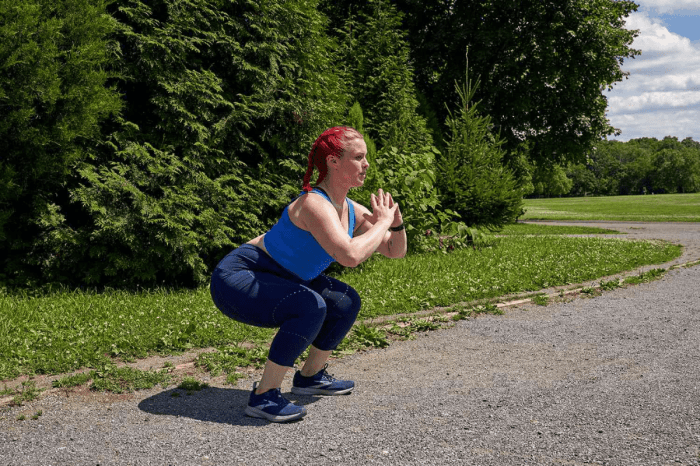Introduction

Weight loss exercises for beginners – Embarking on a weight loss journey can be daunting, but regular exercise is a crucial cornerstone for beginners seeking to shed extra pounds and improve their overall well-being.
Incorporating exercise into your routine not only aids in weight loss but also offers a myriad of health benefits, including enhanced cardiovascular health, increased muscle mass, improved sleep quality, and reduced risk of chronic diseases like type 2 diabetes and heart disease.
Benefits of Exercise for Weight Loss
- Increased Calorie Expenditure:Exercise elevates your metabolic rate, leading to a higher number of calories burned throughout the day.
- Enhanced Fat Oxidation:Physical activity stimulates the breakdown of stored fat, utilizing it as an energy source.
- Preservation of Muscle Mass:Regular exercise helps maintain muscle tissue, which is essential for a healthy metabolism and overall body composition.
Benefits of Exercise for Overall Health
- Improved Cardiovascular Health:Exercise strengthens the heart and blood vessels, reducing the risk of heart disease and stroke.
- Increased Bone Density:Weight-bearing exercises like walking and running help build bone density, reducing the risk of osteoporosis.
- Enhanced Mood and Cognitive Function:Exercise releases endorphins, which have mood-boosting and stress-reducing effects. It also improves blood flow to the brain, enhancing cognitive function.
Types of Weight Loss Exercises
Weight loss exercises for beginners should be accessible, effective, and enjoyable to maintain consistency and motivation. A well-rounded routine incorporates various types of exercises to target different energy systems and muscle groups, maximizing calorie expenditure and overall fitness. Here are some suitable options for beginners:
Bodyweight Exercises
Bodyweight exercises utilize your own body as resistance, making them convenient and cost-effective. They improve core strength, stability, and flexibility while burning calories:
Squats
Engage multiple lower body muscles, strengthening legs and glutes. Stand with feet shoulder-width apart, lower your body as if sitting back into a chair, keeping your back straight and chest up.
Push-ups
Target the upper body, particularly the chest, triceps, and shoulders. Start in a plank position, with hands shoulder-width apart and body forming a straight line from head to heels. Lower your body by bending your elbows, keeping your core engaged.
Lunges
Strengthen legs and improve balance. Step forward with one leg, bending both knees to 90 degrees. Keep your front knee aligned with your ankle and your back knee close to the ground.
Cardio Exercises
Cardio exercises elevate your heart rate and increase calorie burn. They are essential for cardiovascular health and overall endurance:
Brisk Walking
An accessible and low-impact cardio exercise. Aim for a pace where you can talk but not sing.
Jogging
A more intense form of running that burns more calories. Start gradually and increase distance and intensity as you progress.
Swimming
A full-body workout that provides cardiovascular benefits while being gentle on joints.
Strength Training Exercises
Strength training builds muscle mass, which boosts metabolism and helps burn fat. It also improves bone density and functional strength:
Dumbbell Rows
Target back muscles, shoulders, and arms. Hold dumbbells in each hand, hinge at the hips, and row the weights up towards your chest.
Bench Press
Focuses on the chest, triceps, and shoulders. Lie on a bench with dumbbells or a barbell, lower the weights to your chest, and press them back up to the starting position.
Leg Press
Strengthens the lower body, particularly the quadriceps and glutes. Sit in a leg press machine, position your feet on the platform, and press the weight away from you.
Exercise Plan for Beginners: Weight Loss Exercises For Beginners
Beginning an exercise regimen can be daunting, but it’s essential to start gradually and progress at a pace that suits your fitness level. Here’s a sample exercise plan for beginners, along with tips for increasing intensity and duration over time.
Frequency, Duration, and Intensity
Start with 2-3 days of exercise per week, gradually increasing to 4-5 days as you get stronger. Aim for 30-45 minutes of moderate-intensity exercise, such as brisk walking or cycling. As you progress, gradually increase the duration and intensity of your workouts.
Tips for Gradual Progression, Weight loss exercises for beginners
- Listen to your body and rest when needed.
- Start with short workouts and gradually add more time and intensity.
- Choose activities you enjoy to make exercise more sustainable.
- Set realistic goals and celebrate your progress.
Importance of Rest and Recovery
Rest and recovery are crucial for muscle growth and repair. Aim for at least one rest day per week and get 7-9 hours of sleep each night. During rest days, engage in light activities like stretching or yoga to promote relaxation and reduce muscle soreness.
Nutrition for Weight Loss
Proper nutrition is crucial for successful weight loss. A balanced diet and calorie deficit are essential for creating a sustainable and healthy weight loss journey.
A balanced diet ensures the body receives all the necessary nutrients for optimal functioning. It should include a variety of fruits, vegetables, whole grains, lean protein, and healthy fats. Whole, unprocessed foods should form the foundation of a healthy diet.
Calorie Deficit
To lose weight, you need to create a calorie deficit. This means consuming fewer calories than you burn. The number of calories needed varies depending on factors such as age, weight, height, and activity level.
Healthy Food Choices
- Choose nutrient-rich foods over processed or sugary options.
- Opt for fruits and vegetables as snacks instead of chips or candy.
- Select lean protein sources like fish, chicken, beans, or tofu.
- Choose whole grains over refined grains.
- Limit unhealthy fats found in processed foods, fried items, and fatty meats.
Portion Control
Portion control is essential for managing calorie intake. Use measuring cups and spoons to ensure accurate portions. Pay attention to serving sizes listed on food labels.
Motivation and Support

Embarking on a weight loss journey can be daunting, especially for beginners. Staying motivated and maintaining consistency can pose challenges. However, with the right strategies, you can overcome these obstacles and achieve your goals.
Understanding common pitfalls and developing coping mechanisms is crucial. Setting realistic, achievable goals can prevent discouragement and boost motivation. Finding an exercise buddy or joining a support group provides accountability and encouragement. Additionally, tracking your progress and celebrating milestones can help you stay focused and motivated.
Setting Realistic Goals
- Start with small, manageable goals that you can gradually increase as you progress.
- Break down large goals into smaller, more achievable steps to avoid feeling overwhelmed.
- Set both short-term and long-term goals to maintain motivation and track your overall progress.
Finding an Exercise Buddy or Support Group
- Exercising with a friend or joining a support group can provide motivation and accountability.
- Share your goals with your buddy or group to foster a sense of community and support.
- Regular check-ins and encouragement can help you stay on track and overcome challenges.
Staying Accountable and Tracking Progress
- Keep a journal or use a fitness tracker to monitor your workouts, progress, and setbacks.
- Review your progress regularly to identify areas for improvement and stay motivated.
- Celebrate your successes, no matter how small, to maintain a positive mindset and stay motivated.
Safety Precautions
To ensure a safe and effective weight loss journey, it is crucial to prioritize safety precautions. These include warming up before workouts and cooling down afterward, preventing injuries, and listening to your body.
Warming up prepares your body for physical activity by increasing blood flow to your muscles, improving range of motion, and reducing the risk of injuries. Cooling down helps your body recover by gradually reducing your heart rate and body temperature.
Preventing Injuries
- Use proper form during exercises to avoid muscle strains or joint pain.
- Start gradually and increase the intensity and duration of workouts slowly to prevent overuse injuries.
- Wear appropriate shoes and clothing for your workouts to provide support and comfort.
- Avoid exercising if you are experiencing pain or discomfort.
Listening to Your Body
Pay attention to how your body feels during and after workouts. If you experience any pain, stop the exercise and consult a healthcare professional. It is also important to take rest days to allow your body to recover and prevent burnout.